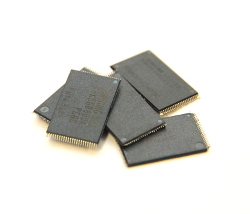Intro

As a hacker, just like most other occupations that require physical work, your toolset can make or break you. If you can't solder SMD components because your soldering iron is uncontrolled or has a point that's too big, forget about hacking on SMD pcbs with tiny 0402 components. The same goes for e.g. programmers: if you don't have an AVR programmer, programming AVRs is going to be impossible. The advantage, however, is that we can hack together our own tools: you can still program an AVR if you, for example, have an Arduino board you can persuade to act as a programmer.
I have run into a similar problem in the past. When security-testing the 'secure' USB-sticks I got my hands on in the past, I needed a way to directly read the NAND-flash these sticks use to store the data on. For that, I created a quick hack: a NAND-reader consisting of a small PCB the flash had to be soldered on and a parallel port interface. There was no voltage conversion apart from some resistors to limit the current from the 5V parallel port to the 3.3V flash chip and the software was a horrific hack, but the contraption worked: I now had a tool to read out NAND flash, even if it was tied together with the solder and the software equivalent of lots of duckttape.
Since then, I've been getting a slow but steady trickle of requests for the code and schematics for the nand reader. I've never been willing to release those because it's such a hack. It also uses the parallel port, something that is unavailable in more and more PCs nowadays.
Recently, I had the need to read out a NAND-flashchip again. Ofcourse, I could get out the old device, try to find a parallel port somewhere and hope the software still worked. I could also build a new one and improve both the software and hardware to something a bit less hack-ish.
1 Next »